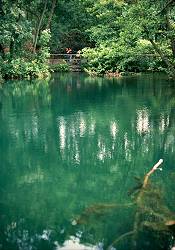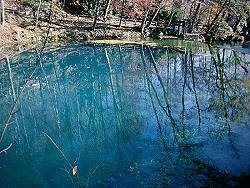Vauclusian Spring
Gushing Spring
vauclusian spring.
A large spring or exsurgence of an underground river, generally from limestone, that varies greatly in output and is impenetrable except with diving apparatus.
Synonym, gushing spring.
ojo, ojo de agua. (Spanish.)
An artesian spring in limestone regions, especially one forming a small pond; a vauclusian spring.
Watson Hiner Monroe (1970): A Glossary of Karst Terminology, Geological Survey Water-supply Paper 1899-k, Library of Congress catalog-card No. 75-607530
DOI
online


The english classification of springs after the type locale, in this case Vaucluse in France, does not explain much. There are numerous attempts in geology to classify springs after the geological situation. Only some are actually relevant for karst. Here we have only two, a result of the abundance of caves allowing the free flow of water underground. The resurgences, where the cave ends with a portal where the river flows out horizontally, and it is typically possible to enter the cave. And the deep wells which for a blue pool which is deep, with a water filled cave system which is below the water level. In short, below water table means submerged, or above water table means river cave. So the vauclusian spring is the submerged type.
The Vaucluse Spring is a spring cave that lies very deep, significantly deeper than the spring, and is thus completely filled with water. Usually, such a situation is explained by the fact that the cave was formed when the drainage was deeper. Then the valley was probably not deepened further, but filled in with boulders. Reasons for such developments are typically climatic changes, but also tectonic uplift or subsidence. In the case of the Vaucluse, as with many caves in southern France, the Messinian salinity crisis was the cause. At that time, the Mediterranean Sea was very dry and very salty because there was no connection to the Atlantic Ocean. And the sea level of the Mediterranean was 250 m below sea level. Accordingly, an underground drainage system formed to this level.
Water (H2O) is blue. The color of H2O is so faint that we are not able to observe this in small amounts of water. To actually see this, a relatively large mass of H2O is required. The color is due to the selective absorption of light. Light is absorbed and converted into heat, quite obvious if you say "the water gets warm when the sun shines on it". In other words, water is not really transparent, it’s a filter which absorbs all light visible for the human eye, but the blue frequencies less. After some distance only the blue light remains, the water gets blue.
Such a vauclusian spring is typically intensive blue or sometimes even intensive green, and it is not possible to explain this with the natural blue colour of water. The reason is simply that there is no H2O, there is karst water which contains a lot of things, but especially a large amount of carbon dioxide and limestone. This changes the physical properties and intensifies the blue filter effect massively. As a result numerous deep karst springs all over the world are called Blue Spring, Pozo Azul, or Blautopf. There are legends of fairies throwing in a bottle of blue ink every day. But we know now: it’s the limestone.
Despite the blue springs there are green spring. They have an intensive medium green colour, as spectacularly green as the blue springs are spectacularly blue. All those springs are in gypsum karst, there is no limestone but gypsum in the water. And gypsum with its sulfur content changes the frequency of the less absorbed light towards green
- Examples
 Nascentes do Alviela, Portugal
Nascentes do Alviela, Portugal Pozo Azul, Spain
Pozo Azul, Spain Poço Azul, Brazil
Poço Azul, Brazil Blaue Quelle, Austria
Blaue Quelle, Austria Blautopf, Germany
Blautopf, Germany Blue Lake, Podlubovo, Russia
Blue Lake, Podlubovo, Russia Keterisi Mineral Vaucluse, Georgia
Keterisi Mineral Vaucluse, Georgia Krasny Klutch Spring, Russia
Krasny Klutch Spring, Russia Sarva Spring Lake, Russia
Sarva Spring Lake, Russia Syri i kaltër, Albania
Syri i kaltër, Albania Fontaine de Vaucluse, France
Fontaine de Vaucluse, France
 Search DuckDuckGo for "Vauclusian Spring"
Search DuckDuckGo for "Vauclusian Spring" Karst spring - Wikipedia (visited: 15-JUL-2021)
Karst spring - Wikipedia (visited: 15-JUL-2021)
 Index
Index Topics
Topics Hierarchical
Hierarchical Countries
Countries Maps
Maps